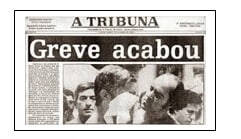Assessment of Portuguese is proposed to students in the eighth or ninth year of elementary school, with exercises on figures of speech, language functions, reading and text interpretation.
This Portuguese Language activity is available for download in an editable Word template, ready to print in PDF and also the completed activity.
Download this activity from:
SCHOOL: DATE:
PROF: CLASS:
NAME:
Read the poem “Love's without reason” and answer questions 1 and 2
I love you because I love you,
You don't need to be a lover,
and you don't always know how to be.
I love you because I love you.
love is a state of grace
and with love you don't pay.
love is given for free,
is sown in the wind,
in the waterfall, in the eclipse.
love runs away from dictionaries
and to various regulations.
i love you because i don't love
enough or too much to me.
Because love is not exchanged,
does not conjugate or love.
Because love is love to nothing,
happy and strong in himself.
love is death's cousin,
and the victorious death,
no matter how much they kill him (and they do)
every moment of love.
Carlos Drummond de Andrade
1) Check the correct alternative in relation to the text “Love's without reasons”.
a) The text genre above is a poem, as it is structured as follows: stanzas (which is each line of the poem) and verses (which is the set of stanzas).
b) The text genre above is a poem, as it is structured as follows: verses (which is each line of the poem) and stanzas (which is the set of verses).
2) We can say that the function of the language that predominates in the text above is:
a) ( ) the referential function, whose real purpose is to inform something.
b) ( ) the emotive function, whose main objective is to transmit emotions and feelings.
c) ( ) the referential function, whose main objective is to transmit emotions and feelings.
d) ( ) the emotive function, whose real objective is to inform about something.
3) Analyze the images below and tick only one alternative, indicating which language predominates in each of them:

a) catchy language
b) referential language

a) catchy language
b) referential language

a) catchy language
b) referential language

a) catchy language
b) referential language

a) catchy language
b) referential language
4) Identify the figures of speech present in the music excerpts below:
The) "…Like an angel You appeared in my life. Uuuh, like an angel….” Like an angel – César Menotti and Fabiano.
A:
b) “…I woke up alone, in an empty bed. My heart that was gone, without saying if it came back later…” New Outfit- Come back to me.
A:
c) “…Unbridled cruel passion, I bring you a thousand stolen roses...” Cazuza – Exaggerated.
A:
d) "...There would be no sound if there was no silence, there would be no light if not darkness. Life is just like that, day and night, no and yes. Certain Things- Lulu Santos.
A:
e) “…I am hers and she is mine. And we always want more. if she tells me to go away I go out and she calls back. Leandro and Leonardo – Between slaps and kisses.
A:
f) “I wanted to accept people as they are. Each one knows the joy and pain that brings in the heart…” Epitaph – Titans.
A:
g) "...See that moon that shines in the sky, if you ask me I'll get it just for give it to you…” Exaltasamba – See that moon.
A:
H) "…rain rain rain come wash this longing….” Rain- João Bosco and Vinícius.
A:
i) “…Seasons changed, nothing changed. But I know something happened…” For now – Cassia Eller.
A:
Read the text: The caboclo, the priest and the student and answer questions 5, 6 and 7
A student and a priest were traveling through the sertão, with a caboclo as their luggage carrier. They were given a small goat's cheese in a house. Not knowing how to divide it, even because a small piece would arrive for each one, the priest decided that everyone would sleep and the cheese would be the one that had, during the night, the most beautiful dream, thinking to deceive everyone with its resources oratorios. All accepted and went to sleep. At night, the caboclo woke up, went to the cheese and ate it. In the morning, the three sat at the table to have breakfast and each had to tell their dream. The priest said he dreamed of Jacob's ladder and described it brilliantly. Through her he triumphantly ascended to heaven. The student, then, narrated that he had dreamed already inside the sky waiting for the priest who was going up. The caboclo smiled and said: – I dreamed that I saw your priest going up the stairs and your doctor there in heaven, surrounded by friends. I stayed on the ground and shouted: – Your doctor, your priest the cheese! You have forgotten the cheese. Then, youmices answered from heaven: - Eat the cheese, caboclo! Eat the cheese, we're in heaven, we don't want the cheese.-The dream was so strong that I thought it was true, I got up, while you mycesis slept and ate the cheese...
(CASCUDO, Luiz da Câmara, Traditional tales from Brazil)
5) Check the alternative that indicates the order of events narrated in the first paragraph of the text:
a) arrival at the house, the cheese, the agreement, the trip.
b) the cheese, the trip, the solution, the rest at home.
c) the trip, a house, the cheese, the agreement, the unexpected solution.
d) the caboclo, the two friends, the trip, the agreement.
6) The narrative conflict is centered on the decision:
a) to divide the cheese into three equal parts.
b) whether or not to deliver the cheese to the character who most needed it.
c) to sell the cheese and split the money between the characters.
d) to choose a form of competition in which the winner would receive the entire cheese.
7) The mood of the narrative is present:
a) in the ending, as it narrates the cleverness of the caboclo, who manages to deceive the priest and the student.
b) in the development of the narrative, that is, in the speech of the priest who shows his lack of character by taking advantage of his superiority.
c) in the introduction of the narrative, when the simplicity of the student becomes evident.
d) in the fun situation of having only one cheese for three people.
By Rosiane Fernandes Silva – graduated in Letters
The answers are in the link above the header.
 report this ad
report this ad